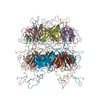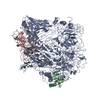[English] 日本語
 Yorodumi
Yorodumi- PDB-6yeg: Hybrid structure of the SPP1 tail tube by solid-state NMR and cry... -
+ Open data
Open data
- Basic information
Basic information
| Entry | Database: PDB / ID: 6yeg | ||||||||||||||||||||||||||||
|---|---|---|---|---|---|---|---|---|---|---|---|---|---|---|---|---|---|---|---|---|---|---|---|---|---|---|---|---|---|
| Title | Hybrid structure of the SPP1 tail tube by solid-state NMR and cryo EM - Final EM Refinement | ||||||||||||||||||||||||||||
 Components Components | Tail tube protein gp17.1* Keywords KeywordsVIRAL PROTEIN / complex / tail tube / scaffolding / DNA transport | Function / homology |  Function and homology information Function and homology informationviral head-tail joining / virus tail, tube / symbiont genome ejection through host cell envelope, long flexible tail mechanism / viral translational frameshifting Similarity search - Function Biological species |  Bacillus phage SPP1 (virus) Bacillus phage SPP1 (virus)Method | ELECTRON MICROSCOPY / SOLID-STATE NMR / helical reconstruction / na / cryo EM / Resolution: 4 Å |  Authors AuthorsZinke, M. / Sachowsky, K.A.A. / Zinn-Justin, S. / Ravelli, R. / Schroder, G.F. / Habeck, M. / Lange, A. | Funding support | European Union, 1items |
 Citation Citation Journal: Nat Commun / Year: 2020 Journal: Nat Commun / Year: 2020Title: Architecture of the flexible tail tube of bacteriophage SPP1. Authors: Maximilian Zinke / Katrin A A Sachowsky / Carl Öster / Sophie Zinn-Justin / Raimond Ravelli / Gunnar F Schröder / Michael Habeck / Adam Lange /    Abstract: Bacteriophage SPP1 is a double-stranded DNA virus of the Siphoviridae family that infects the bacterium Bacillus subtilis. This family of phages features a long, flexible, non-contractile tail that ...Bacteriophage SPP1 is a double-stranded DNA virus of the Siphoviridae family that infects the bacterium Bacillus subtilis. This family of phages features a long, flexible, non-contractile tail that has been difficult to characterize structurally. Here, we present the atomic structure of the tail tube of phage SPP1. Our hybrid structure is based on the integration of structural restraints from solid-state nuclear magnetic resonance (NMR) and a density map from cryo-EM. We show that the tail tube protein gp17.1 organizes into hexameric rings that are stacked by flexible linker domains and, thus, form a hollow flexible tube with a negatively charged lumen suitable for the transport of DNA. Additionally, we assess the dynamics of the system by combining relaxation measurements with variances in density maps. #1:  Journal: Biorxiv / Year: 2020 Journal: Biorxiv / Year: 2020Title: Spinal Column Architecture of the Flexible SPP1 Bacteriophage Tail Tube Authors: Zinke, M. / Sachowsky, K.A.A. / Oster, C. / Zinn-Justin, S. / Ravelli, R. / Schroder, G.F. / Habeck, M. / Lange, A. History |
|
- Structure visualization
Structure visualization
| Movie |
 Movie viewer Movie viewer |
|---|---|
| Structure viewer | Molecule:  Molmil Molmil Jmol/JSmol Jmol/JSmol |
- Downloads & links
Downloads & links
- Download
Download
| PDBx/mmCIF format |  6yeg.cif.gz 6yeg.cif.gz | 343.5 KB | Display |  PDBx/mmCIF format PDBx/mmCIF format |
|---|---|---|---|---|
| PDB format |  pdb6yeg.ent.gz pdb6yeg.ent.gz | 283.6 KB | Display |  PDB format PDB format |
| PDBx/mmJSON format |  6yeg.json.gz 6yeg.json.gz | Tree view |  PDBx/mmJSON format PDBx/mmJSON format | |
| Others |  Other downloads Other downloads |
-Validation report
| Summary document |  6yeg_validation.pdf.gz 6yeg_validation.pdf.gz | 602 KB | Display |  wwPDB validaton report wwPDB validaton report |
|---|---|---|---|---|
| Full document |  6yeg_full_validation.pdf.gz 6yeg_full_validation.pdf.gz | 858 KB | Display | |
| Data in XML |  6yeg_validation.xml.gz 6yeg_validation.xml.gz | 107.8 KB | Display | |
| Data in CIF |  6yeg_validation.cif.gz 6yeg_validation.cif.gz | 92.5 KB | Display | |
| Arichive directory |  https://data.pdbj.org/pub/pdb/validation_reports/ye/6yeg https://data.pdbj.org/pub/pdb/validation_reports/ye/6yeg ftp://data.pdbj.org/pub/pdb/validation_reports/ye/6yeg ftp://data.pdbj.org/pub/pdb/validation_reports/ye/6yeg | HTTPS FTP |
-Related structure data
| Related structure data |  10792MC  6yq5C M: map data used to model this data C: citing same article ( |
|---|---|
| Similar structure data | |
| Other databases |
- Links
Links
- Assembly
Assembly
| Deposited unit | 
| |||||||||
|---|---|---|---|---|---|---|---|---|---|---|
| 1 |
| |||||||||
| NMR ensembles |
|
- Components
Components
| #1: Protein | Mass: 19674.451 Da / Num. of mol.: 12 Source method: isolated from a genetically manipulated source Source: (gene. exp.)  Bacillus phage SPP1 (virus) / Gene: 17.1 / Production host: Bacillus phage SPP1 (virus) / Gene: 17.1 / Production host:  |
|---|
-Experimental details
-Experiment
| Experiment |
| ||||||||||||||||||||||||||||||||||||||||||||||||||||||||||||||||||||||||||||||||||||||||||||||||||||||||||||||||||
|---|---|---|---|---|---|---|---|---|---|---|---|---|---|---|---|---|---|---|---|---|---|---|---|---|---|---|---|---|---|---|---|---|---|---|---|---|---|---|---|---|---|---|---|---|---|---|---|---|---|---|---|---|---|---|---|---|---|---|---|---|---|---|---|---|---|---|---|---|---|---|---|---|---|---|---|---|---|---|---|---|---|---|---|---|---|---|---|---|---|---|---|---|---|---|---|---|---|---|---|---|---|---|---|---|---|---|---|---|---|---|---|---|---|---|---|
| EM experiment | Aggregation state: HELICAL ARRAY / 3D reconstruction method: helical reconstruction | ||||||||||||||||||||||||||||||||||||||||||||||||||||||||||||||||||||||||||||||||||||||||||||||||||||||||||||||||||
| NMR experiment |
|
- Sample preparation
Sample preparation
| Component | Name: SPP1 tail tube / Type: COMPLEX / Entity ID: all / Source: RECOMBINANT | |||||||||||||||||||||||||||||||||||||||||||||||||||||||||||||||||||||||||||
|---|---|---|---|---|---|---|---|---|---|---|---|---|---|---|---|---|---|---|---|---|---|---|---|---|---|---|---|---|---|---|---|---|---|---|---|---|---|---|---|---|---|---|---|---|---|---|---|---|---|---|---|---|---|---|---|---|---|---|---|---|---|---|---|---|---|---|---|---|---|---|---|---|---|---|---|---|
| Source (natural) | Organism:  Bacillus phage SPP1 (virus) Bacillus phage SPP1 (virus) | |||||||||||||||||||||||||||||||||||||||||||||||||||||||||||||||||||||||||||
| Source (recombinant) | Organism:  | |||||||||||||||||||||||||||||||||||||||||||||||||||||||||||||||||||||||||||
| Buffer solution | pH: 7.4 | |||||||||||||||||||||||||||||||||||||||||||||||||||||||||||||||||||||||||||
| Buffer component |
| |||||||||||||||||||||||||||||||||||||||||||||||||||||||||||||||||||||||||||
| Specimen | Embedding applied: NO / Shadowing applied: NO / Staining applied: NO / Vitrification applied: YES | |||||||||||||||||||||||||||||||||||||||||||||||||||||||||||||||||||||||||||
| Vitrification | Cryogen name: ETHANE | |||||||||||||||||||||||||||||||||||||||||||||||||||||||||||||||||||||||||||
| Details |
| |||||||||||||||||||||||||||||||||||||||||||||||||||||||||||||||||||||||||||
| Sample |
|
 Movie
Movie Controller
Controller


 UCSF Chimera
UCSF Chimera





 PDBj
PDBj

